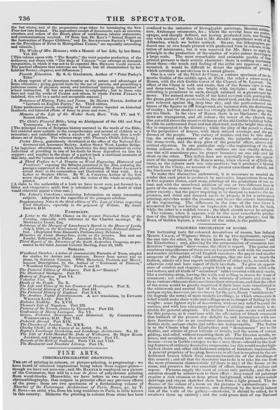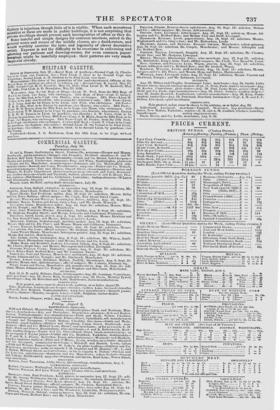COLOURED DECORATION OF ROOMS.
THE increasing taste for coloured decorations of rooms, has induced Messrs. CRACE, of Wigmore Street, to fit up two apartments, opening the one into the other, in the styles known as the "Renaissance" and the Elizabethau ; and, allowing for the accumulation of ornament inci- dental to " specimen " show-rooms, the (fleet is superb. The quaint and cumbrous magnificence of these two styles accords well with the massive and sombre architecture of old English mansions : the gayer and smaller snugness of the gabled villas and cottages, that are now so much the fashion, admits of a less superb modification of either style, to enrich the otherwise cold and bare aspect of their interiors. To give an appear- ance of comfort and elegance, people block up small rooms with sofas and settees, and all kinds of" occasional " tables covered with nick-nacks, ' like a curiosity-shop, leaving the walls and ceiling to starve for want of ornament ; not reflecting that it is the mixture of colours and forms in these various oddments that constitutes their attractions, and that the effect of the room would be greatly improved if their hues were transferred to the whitewash and neutral tint of the ceiling and blank walls. These antique styles, however, are too heavy for the pert, flimsy "architecture" (to degrade the term) of most modern dwellings, in which ornaments in relief would make their walls and ceilings seem in danger of falling by the weight : some lighter style of decoration, without any relict' beyond the cornice, and with less sumptuous profusion of gilding and colour, is de- sirable for general adoption. The Italian Arabesque seems well suited for this purpose, as it combines with the affectation of Greek ornament that builders of the present day delight in, and harmonizes with mo- dern furniture—for to an apartment decorated in the Elizabethan or Gothic style, antique chairs and tables are indispensable. The Italian is to the Classic what the Elizabethan and "Renaissance" are to the Gothic, and admits of great latitude of details, and the union of colour, gilding, and relief, without requiring them all. The Grecian scrolls, ro- settes, and mouldings, that are constantly introduced into modern-built houses—even in Gothic cottages we have seen them—should be the lead- ing features of ordinary decorative ornaments; but this would render high- backed chairs and other old-fashioned articles of furniture inadmissible. A general propriety of keeping, however, is all that is required in the no- fashioned houses which form nineteen-twentieths of the dwellings of this country ; and all that the decorator has to do is to take his cue from the most prominent characteristic (it' there is any) of the house or the room, and preserve the two essentials of efl'ect, harmony of colour and repose. Pictures supply the want of colour only partially, and the de- coration should be subservient to their effect : deep-toned oil paintings require a rich crimson or deep green background, while water-colour drawings and crayon sketches show best from a light ground. The in- fluence of the colour of a room on the pictures is extraordinary: the pictures at Dulwich, for instance, are destroyed by the horrid salmon tint of the walls of the gallery—shark-tint, it should be called, for it swallows them up entirely ; and the cold green drab of our National Gallery is injurious, though little of it is visible. 'When such monstrous mistakes as these are made in public buildings, it is not surprising that private dwellings should present such incongruities of effect as they do. Some tasteful and simple designs for common interiors, suited to the general wants and means of the middle classes, are a desideratum, and would worthily exercise the taste and ingenuity of clever decorative artists. Expense is not the difficulty to be overcome in enlivening and adorning our parlours and drawing-roo:theirs, or even common paper-
hangings might be tastefully employed patterns are very much improved already.



























 Previous page
Previous page